Written and photographed by Mary L. Peachin
Vol. 10 No. 3
 Pelting rain drenched us as Pedro poled the panga through the muddy channels brushing the black mangroves of Rio Lagartos. Casting a yellow “San Felipe special,” a tarpon took the fly leaping into aerobatic 360s as it exploded from the shallow water. Like lightning, it sped around mangrove roots then under our boat. Sabalito or small tarpon offer challenging hookups, numerous jumps out of the water, and a fight that isn’t an hour-long arm-wrencher. These fish are strong with cunning equal to that of a bone fish. Less than 250 anglers have fished theremote, Yucatan Fly Fishing’s tarpon route, and only a handful have fished Campeche, located in southwestern region in the Gulf of Mexico.
Pelting rain drenched us as Pedro poled the panga through the muddy channels brushing the black mangroves of Rio Lagartos. Casting a yellow “San Felipe special,” a tarpon took the fly leaping into aerobatic 360s as it exploded from the shallow water. Like lightning, it sped around mangrove roots then under our boat. Sabalito or small tarpon offer challenging hookups, numerous jumps out of the water, and a fight that isn’t an hour-long arm-wrencher. These fish are strong with cunning equal to that of a bone fish. Less than 250 anglers have fished theremote, Yucatan Fly Fishing’s tarpon route, and only a handful have fished Campeche, located in southwestern region in the Gulf of Mexico.
The route begins in the northwestern reserve of Rio Lagartos near San Felipe, a village of 2000 inhabitants, who primarily subsist by fishing for octopus. Before sunrise the fishermen leave a small harbor in wooden boats poling with handmade bamboo outriggers. If they are lucky, they can haul in 5 to 6 pulpo by re-using a single crab for bait. Some fisherman seeped out a living fishing for lobster.
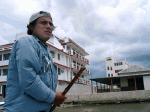 “Not many Americans come to San Felipe.” Ruz has fished the area for nine years, but it was only three years ago when he persuaded Mena and his family to build Tarpon Cay lodge on San Felipe’s malecon or ocean walk. The lodge, which has the appearance of a hotel, is located “three steps to the boat, or maybe two on a higher tide.”
“Not many Americans come to San Felipe.” Ruz has fished the area for nine years, but it was only three years ago when he persuaded Mena and his family to build Tarpon Cay lodge on San Felipe’s malecon or ocean walk. The lodge, which has the appearance of a hotel, is located “three steps to the boat, or maybe two on a higher tide.”
While medium-size tarpon in the 50 pound range can be released, most anglers prefer the feisty eight-ish pound sabalito tykes. Stalking and hooking up requires a strong arm and expertise with a fly rod. Always fishing in skinny water, the height of the tide is critically. While the pangas can easily navigate in six inches of water, the ebb of the tide turns the harbor into a muddy flat. On one occasion, we had to disembark on the jetty walking its wall like gymnasts on a balance beam.
Two years ago, after graduating with a degree in tourism at a Cancun college, Ruz proposed the idea of bringing anglers to San Felipe to Mena. Ruz then hired and taught four locals all aspects of fly fishing gleaned from his experience in guiding day trips in Cancun.
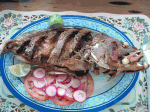 Most tarpon fisheries are seasonal, but the fish are full time local residents in Tarpon Cay. During summer months, the average fish release is 30 percent greater when migratory fish arrive. While most of the sabalitos feed in the one to three foot “chocolate” or muddy water around the mangroves, they also roll in the clearer visibility of Bahia Sabalito.
Most tarpon fisheries are seasonal, but the fish are full time local residents in Tarpon Cay. During summer months, the average fish release is 30 percent greater when migratory fish arrive. While most of the sabalitos feed in the one to three foot “chocolate” or muddy water around the mangroves, they also roll in the clearer visibility of Bahia Sabalito.
Owners Captain Marco Ruz and Jesiel Mena, are protecting and conserving this remarkable, renewable resource, and the future of a unique fishery with the cooperation of San Felipe’s local government. They’re proud to show guests their tarpon “nursery.” Along the road, on the outskirts of Rio Lagartos, six inch, two-plus pound fry are manually transplanted from Bahia Sabalito. Here, they mature in protected ponds where they feed on minnow-size mullet. The following year, they’ll navigate through man-made canals back to the bay.
Every year Ruz finds larger tarpon in new spots. Might not be true science, but his years of familiarity with the fishery’s resources adds some validity to his cause. Ruz has witnessed thousands of rolling tarpon grow in these wetlands and, sadly, watched sabalitos die during years when the lack of winter rain dries the ponds. These guys are remarkably conservation oriented.
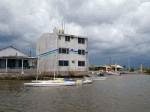 Ruz is a strong believer in the size of the fly and barbless hook. Small, light, stainless 2-1.0 hooks penetrate the tarpon’s bony mouth, the best tippet is 40 pound shock or 60 when fishing the larger fish. A 9-weight rod loaded with green fly line is his preference, and he uses a 14-foot leader so the fish can’t see the line. These babies spook easily in the clear water of the Bay.
Ruz is a strong believer in the size of the fly and barbless hook. Small, light, stainless 2-1.0 hooks penetrate the tarpon’s bony mouth, the best tippet is 40 pound shock or 60 when fishing the larger fish. A 9-weight rod loaded with green fly line is his preference, and he uses a 14-foot leader so the fish can’t see the line. These babies spook easily in the clear water of the Bay.
Tying his own flies, Ruz favors the smaller four inch size; his favorite action fly is the yellow buck tail “San Felipe special” that pushes water rather than one that pops. He frequently uses a seducer. Ruz finds orange the color of choice in muddy water.
Throwing a stiff, fast action 9-foot Sage TCR. with cork drag, the man can cast-like 50 to 75 feet or more. Yucatan Fly Fishing has the only permit to fish the reserve plus they own their own hotel. For now, they enjoy a monopoly tarpon fishing in San Felipe.
Northern Californians Betty and Paul Wilms returning from their first morning of fishing jumped eleven tarpon. “I love this fishing. I’ve got that ‘quick release’ down pat. Fishing for small tarpon is the most productive close to the mangroves, those bigger ones, a forty minute fight, are too much work.”
Guide Pedro Figueroa poled us out of the harbor during low tide. The 18-foot fiberglass panga with Yamaha 40 is a flats boat with a step-up casting platform. Depending on the tidal cycle, anglers usually leave the lodge at 6 in the morning returning at noon for lunch and a siesta. The less productive afternoon can be fished between 4-7:30 pm.
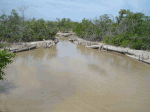 Making our way across the bay toward the remote reserve, we occasionally smelled egg-like sulphur near the black mangroves. Three years ago, hurricane Isadore tore through the area. The combination of dead and new mangroves creates an eerie, yet beautiful appearance.
Making our way across the bay toward the remote reserve, we occasionally smelled egg-like sulphur near the black mangroves. Three years ago, hurricane Isadore tore through the area. The combination of dead and new mangroves creates an eerie, yet beautiful appearance.
It’s not unlike the unique scenery of a Death Valley or the Sahara desert. But in those destinations, you might see other people. Unless there are other anglers at the lodge, with the exception of an occasional distant sighting of an octopus fisherman, the solitude is magnificent.
On our second morning, Marco pointed out a man made Mayan island. While there are only remnants of a wall, the composition of the soil is unique to the area. That morning, the tide was still ebbing. As we idly casted waiting for the incoming tide to carry tarpon from shelter in the mangroves, the skies drenched us, stinging us with raindrops the size of ping pong balls. It was a cool respite from the swelteringheat. And either the rain or flowing current brought the tarpon.
 Marco reminded about having enough line to make a short or long cast. A fast, long retrieval strip entices the bite. The bite is gentle, almost like “suction” and many times, it is so fast the angler misses the hookup. Pressure on the line and the customary bow to the jump is essential. The average fight with sabalitos is 10-15 minutes.
Marco reminded about having enough line to make a short or long cast. A fast, long retrieval strip entices the bite. The bite is gentle, almost like “suction” and many times, it is so fast the angler misses the hookup. Pressure on the line and the customary bow to the jump is essential. The average fight with sabalitos is 10-15 minutes.
Tarpon, like bone fish, can see the boat, the line, your arm casting, and, of course, a line smacking the water. And watch those bird nests or as they say in Mexico “tying a hammock.” Somehow the tarpon always roll about ten feet further than your casting range. When they spook, like bone fish, they seem to “settle” closer to resume eating sardines or mullet without swimming what seems like miles.
Pedro poled miles of channels meandering in and out of small ensenadas or bays. In April, casting close to the mangroves is also good for snook, although the occasional hookup is possible anytime.
Yucatan Fly Fishing’s policy is to release all fish and use only barbless hooks. Spin casters cannot use treble hooks. They don’t permit weighing the fish or more than a quick snap of the camera shutter. Only six anglers a week are allowed to fish or a monthly total of 18.
“Tarpon are fast learners.” Yucatan Fly Fishing has a “rest” program, they rotate fishing areas every several months. “We want this fishery to be great for many years so we have to take care of fish and the area.”
Rio Lagartos is also a birder’s heaven. Wetland and shore birds include flamingos, tiger heron, egrets, frigates in addition to common seabirds. Some European guests travel long distances specifically to bird watch.
Departing San Felipe, we drove four hours along a two lane highway in driving rain to fish in Campeche. After a typical Yucatan Mexican dinner in a small cafe on St. Martin’s plaza, we collapsed in the comfort of the Francis Drake, a small hotel located along the narrow cobblestone steets in the colonial district.
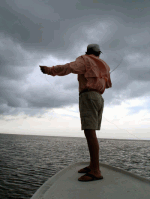 Campeche’s small marina, which docks about seven boats, is a five minute drive from the hotel. Don Belito picked us up dockside driving a larger 23 foot fiberglass panga, the same boat he uses to fish octopus. We motored 25 minutes to the ensenada. Ruz is eager for his own boats to be built. Campeche Fishing Club will use the same custom made pangas as those in Tarpon Cay. Campeche, while not a reserve, has sixty miles of lush mangrove coastline with fewer channels for tarpon to hide. In 2006, Yucatan Fly Fishing will complete construction of a lodge near the San Carlos fort overlooking the Bay of Campeche.
Campeche’s small marina, which docks about seven boats, is a five minute drive from the hotel. Don Belito picked us up dockside driving a larger 23 foot fiberglass panga, the same boat he uses to fish octopus. We motored 25 minutes to the ensenada. Ruz is eager for his own boats to be built. Campeche Fishing Club will use the same custom made pangas as those in Tarpon Cay. Campeche, while not a reserve, has sixty miles of lush mangrove coastline with fewer channels for tarpon to hide. In 2006, Yucatan Fly Fishing will complete construction of a lodge near the San Carlos fort overlooking the Bay of Campeche.
“Just look how shallow the water is.” Fishing in Campeche is more challenging than Tarpon Cay. It is all sight fishing, searching for tarpon hiding like logs in turtle grass. The clarity of the water requires a longer cast. The fish are larger, averaging about 12 pounds.
Snook can be caught under the mangroves, but the real interest is in the tarpon. Ruz landed a 3 to 4 pound snook using a red and white neutralizer. A fly designed by Targus’ Lee Haskins, an orange neutralizer made with foam with eyes and floats just below the surface, was successful.
Like Tarpon Cay, Campeche is also a bird watcher’s paradise. We passed several cormorant and stork rookeries. Anglers may be more familiar with Ascension Bay, south of Cancun, a fishery known for bonefish and permit. But, if you are looking for a remote and challenging adventure, try Yucatan Fly Fishing’s Tarpon Route.
If you go: [email protected] or www.yucatanflyfishing.com
6 fishing days and 7 nights $3995.00.Anglers can fly into Merida or Cancun. Yucatan Fly Fishing provides an airport shuttle of three hours from Cancun or four hours from Merida.
The three hour drive from Cancun to Rio Lagartos Reserve follows streets separated by a medium filled with trees blooming with brilliant orange flamboya and pink oleander before reaching the Autopista Merida-Cancun toll road through the state of Quintana Roo to Yucatan. an almost vehicle-less toll road. The straight road is surrounded on both sides by jungle-trees uprooted by hurricane Emily in July, 2005 can be seen. Small populations of Mayans ride rusted bikes along the road stopping occasionally to gather wood. Their jungle villages do not have electricity so firewood is used for cooking. In some villages, the dominance of a Catholic church, built by Franciscans, is the pillar of the community.
Tarpon Cay Lodge has 18 rooms including an adjacent building with 8 rooms for angler accommodations. The food is primarily fried fish with a local flavor. The “muy amable” friendly staff makes you feel like family. Gilberto “Beto” Alcocer Chavez welcomes “if you want anything, I can do it for you” as he sets down a whole grouper. Mariachi music, wafting from a teaching school next door, serenades guests during one of those majestic tropical sunsets.
Tarpon Cay is basic, clean and comfortable with air conditioning. Typical is the possibility of losing water pressure, electricity and that precious air conditioning. But, it’s all part of the adventure. Releasing sabalito will surely change thoughts of fighting big tarpon.
Campeche is a charming colonial city that, unfortunately, has a Sam’s Club and McDonald’s on the road into town. Until the last decade, the city was walled and its fort overlooks the Bay. We stayed at the small Francis Drake, the 5-star Plaza hotel is another option used by Ruz. The city’s malecon along the bay is the place to be during evening hours.
The tarpon might be smaller and the accommodations more rustic, but fishing for sabalito in the Yucatan, well, don’t miss it. Soon, anglers everywhere will discover this adventure.
